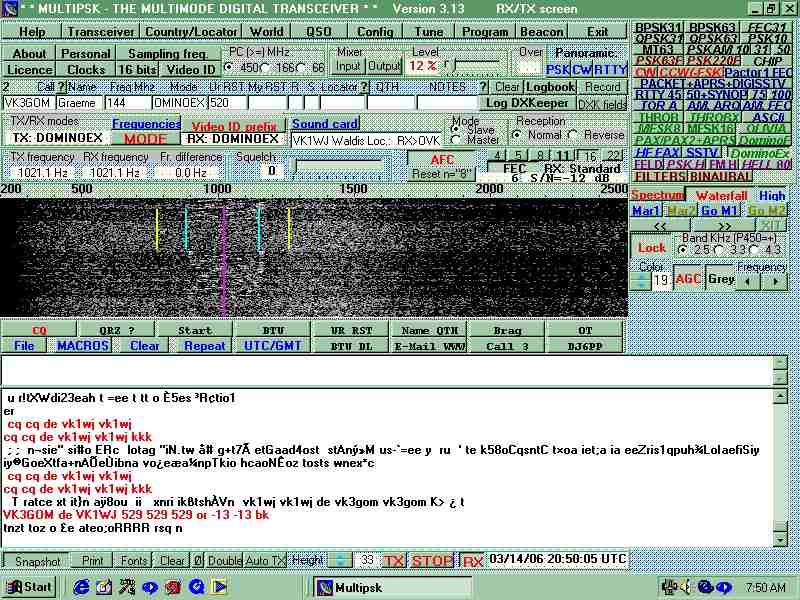HF Style Digital Modes on
2m AE
By Waldis Jirgens VK1WJ
Starting Out
Late November 2005 Graeme VK3GOM in
Bendigo suggested to do some hf-style digital skeds via AE. After some
guesswork we started out with BPSK63 and found that our "windows of
opportunity" were actually quite small - we measured on the 28/12/05
between 7:30 and 8 AM local time 3 "windows" with 98, 48 and again 48
seconds opening time. Recently I wrote a little simulation program
showing the "footprint" of a plane flying between Sydney and Melbourne.
This explains this situation nicely. QSOs between Canberra and Bendigo
are only possible whilst a plane is over Bright! Here a short animated
excerpt:

Other Characteristics of
2m AE Signals
First the rise and fall of an AE signal:
VK3II in FSK441 during
the
Meteor-Scatter session on the
8th of January 2006. I took
4 consecutive screenshots from WSJT version 4.
See the QSB
frequency decreasing during the ascendancy phase and increasing
thereafter:
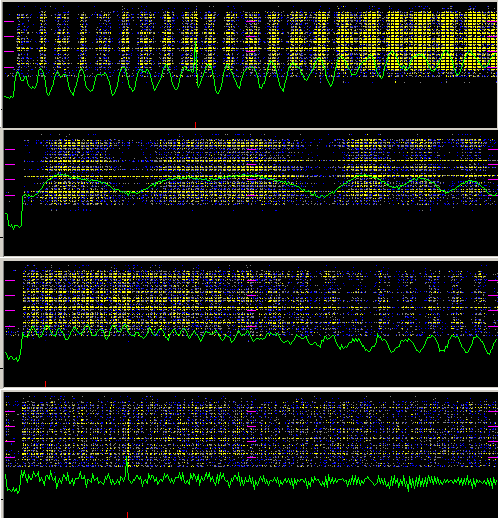
Another such AE signal, this time
VK2ZZF in FSK441 during the
Meteor-Scatter session on the
26th of March 2006.
Note
fast - slow - fast QSB:

Here an unidentified AE signal rising and falling
without any
discernable QSB during the FSK441 session on July 1 2006:


Yet another AE signal in its rapid declining phase -
VK3VHF in
FSK441 during the
Meteor-Scatter session on the
8th of January 2006. I was
beaming South, so this is probably
side-scatter from a plane approaching or departing Canberra airport.
There is
no real
QSB on the signal:
 So there are 2 types of signals, one without any
QSB, appearing out of the noise,
peaking and decreasing, the other with fast QSB when appearing out of
the noise, QSB
frequency decreasing with increasing signal strength and increasing
again with
declining signal strength.
So there are 2 types of signals, one without any
QSB, appearing out of the noise,
peaking and decreasing, the other with fast QSB when appearing out of
the noise, QSB
frequency decreasing with increasing signal strength and increasing
again with
declining signal strength.
The QSB on some signals could be caused by mixing of a Dopplershift
affected signal (reflected at an aircraft)
with a non-Dopplershift affected signal (refracted at a layer of
turbulent air created either at the wingtips
of the aircraft or by hot exhaust gases - akin to an artifical short
lived inversion-layer).
See for instance http://techdigest.jhuapl.edu/td1903/iannuzzelli.pdf.
Another possibility is the involvement of a second aircraft. This
however cannot account for ALL cases of QSB observed on AE signals, see
for
instance the neat and symmetrical 30 second appearance of VK2ZZF above!
Equipment Instability And Dopplershift
On the 30th of January 2006 Graeme
VK3GOM was transmitting in CW and I
ran the spectran program taking screenshots every 46 seconds. We saw
considerable
shifts in frequency and at first put it down to Dopplershift.
However after a discussion with David Tanner, who suggested that the
data might be contaminated by receiver drift in my IC706Mk2
I ran
a test receiving the VK2TWR beacon using the IC706Mk2 and then my
FT290RII as receiver. It turns out that the RX of the
IC706Mk2 is indeed
susceptible to drift, whereas the FT290RII seems rock-solid.
The reason probably is, that the FT290R does not use a fan. Here the
pictures in comparison:
1. IC706Mk2 showing considerable
receiver drift:
 2. FT290RII showing
virtually no receiver drift:
2. FT290RII showing
virtually no receiver drift:
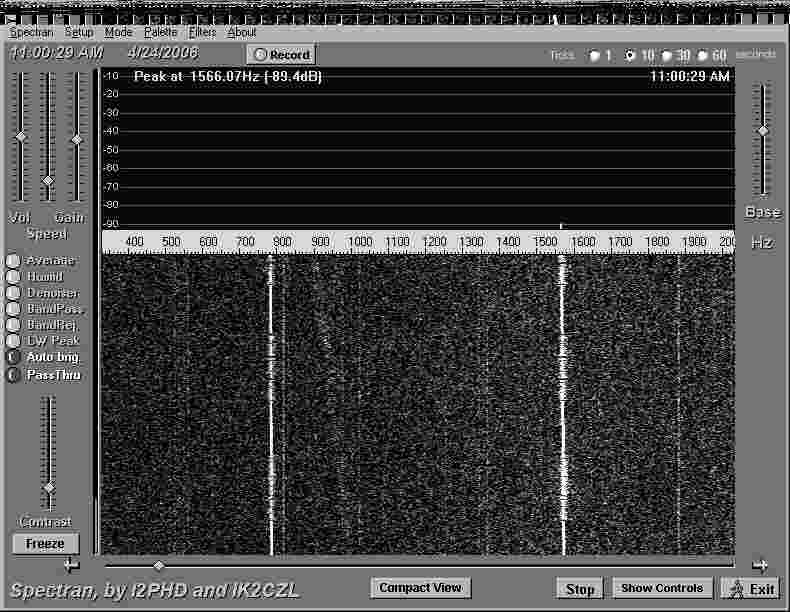
However the noise floor in the FT290RII is around 9 dB higher than in
the IC706Mk2.
That's why 2 subsequent CW tests with VK3GOM using the FT290RII as RX
failed.
Here are all relevant
Spectran screenshots in low resolution
These pictures show that:
- Without Aircraft there was no signal detectable.
- Drift+Dopplershift can be very noticeable. Here it is
around 100 Hertz.
Dopplershift can be predicted
theoretically - see
my software page.
I have a program that can evaluate various scenarios, amongst them the
following one - fairly typical of
an AE QSO:
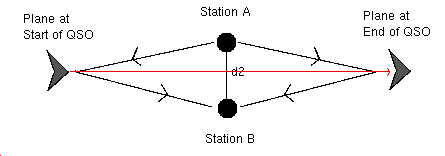

Here is a picture derived from the run of my Dopplershift plotting
program
mentioned before. It assumes that a plane flies at 900 Km/h for more
than an hour perpendicular to the connecting line between two stations
and shows the absolute maximum Dopplershift
imaginable, which won't eventuate in praxi.
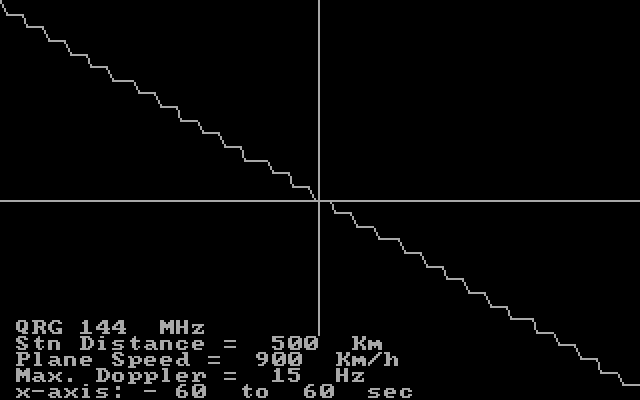
This picture is more
like during a typical QSO of around 2 minute duration. The maximum
Dopplershift is 15 Hertz! Of course the graph should be smooth.

Here is a
Spectran
picture of
the VK2TWR beacon, taken on Thursday
27/4/06. Next to the directly received signal (the broader
sections are the CW-id) you can see two faint and sloping signals
representing reflections off aircraft approaching or departing Canberra
airport. Dopplershift is 15 Hertz at the maximum. So theory and
observation are pretty much in tune!
Operating Procedures
As we saw before: An AE signal can be
very short lived. The frequency
of the signal is not constant but shows variable Dopplershift
(reflexion off a moving object). Complicating the scenario is also the
drift of the RX and TX, which exceeds mostly the Dopplershift.
For this type of signal to be usable on
digital modes one should
have a relatively fast BPS - rate, and use a "continuous signal" mode
like all HF style digimodes. The mode should also be sensitive and the
program should
have excellent AFC to follow the frequency drift. Of course there is no
digital mode that meets all these criteria. Still one can achieve nice
ragchews with these modes,
when in SSB the signal strength is too low down to even exchange a
report!
Graeme VK3GOM and I
arranged several skeds with these modes. Their characteristics are
described in the help files of the Multipsk program.
Of course with the very fast Baud Rates it is essential to use Macro
Buttons for exchanging reports quickly, because nobody can type that
fast. I suggest the following ones (format for MixW) - note that lower
case is preferrable since it is faster to transmit on many modes:
SRST:
<TX><CALL> <CALL> de <MYCALL> <MYCALL>
ur rst is <RSTS> <RSTS> bk <RXANDCLEAR>
SRRST:
<TX><CALL> <CALL> de <MYCALL> <MYCALL>
rrrrrr ur rst is <RSTS> <RSTS> bk <RXANDCLEAR>
SNAK:
<TX><CALL> <CALL> de <MYCALL> <MYCALL>
pse agn rst? rst? bk <RXANDCLEAR>
SAll OK:
<TX><CALL> <CALL> de <MYCALL> <MYCALL>
all copied all copied btu <CALL> de <MYCALL> k
<RXANDCLEAR>
SBYE:
<TX><CALL> <CALL> de <MYCALL> <MYCALL>
tnx qso tnx qso, gl <NAME>, 73!
<CALL> <CALL> DE <MYCALL> <MYCALL> sk
<RXANDCLEAR>
Of course MixW requires you to set up buttons to enable the fast modes.
These are the following:
BPSK63:
<MODE:BPSK31><BAUDRATE:62.50>
QPSK63:
<MODE:QPSK31><BAUDRATE:62.50>
BPSK125:
<MODE:BPSK31><BAUDRATE:125>
QPSK125:
<MODE:QPSK31><BAUDRATE:125>
There are also "Bread and butter" macros like:
CQ:
<TX> cq cq cq de <MYCALL> <MYCALL> <MYCALL>
cq cq cq de <MYCALL> <MYCALL>
cq cq cq de <MYCALL> <MYCALL> kkk <RXANDCLEAR>
QRZ:
<TX>...qrz? qrz? qrz? de <MYCALL> <MYCALL> kkk <RXANDCLEAR>
Programs usable:
MixW - from 2.07 onward. All Macro examples are written to conform to
MixW standards. It can do B(Q)PSK63 and 125.
Multipsk can do BPSK63 and QPSK63, also
PSK63F, PSK220F and
CHIP64, Domino EX, Olivia, Hell 80, Feld Hell, FM Hell.
Stream by IZ8BLY can do PSK63F and
PSK125F - double speed
PSK63F. In Stream one can configure the AFC attack rate, very
useful to counteract drift!
Hellschreiber by IZ8BLY can do Feld Hell,
FM Hell and C/MT Hell.
Multipsk and Stream are Freeware - a
beefed up version of
Multipsk is Shareware. MixW is Shareware, but the trial period lasts 14
days from installation.
For LINUX/FreeBSD: gMFSK. It can do
BPSK63 and Olivia and - in the newest version - also Domino EX.
There are certainly many more. If you use
a different program, check out,
which modes it can do!
QSO Procedures:
Exchange RST like in a hf digital contest.
First enter Callsign and report as soon as you hear your QSO partner,
then hit the "SRST" button as soon as he stops transmitting or the
SRRST button, if he sent you an RST, which you have reeceived. When RST
have been exchanged, hit the "SALL OK" Button. After that you can chew
the rag, as long as the aircraft will allow you...
Tests done:
- BPSK125 versus BPSK63: BPSK63 is more
sensitive and just fast enough to transmit essential QSO exchanges. BPSK125
allows more data to be transmitted.
- QPSK125 / QPSK63: I could not find any noticeable
difference
to the BPSK versions. The "Q" versions are far less drift tolerant, so
BPSK125 / BPSK63 should be better.
- PSK220F with faster speed but FEC added performs well
too.
Comparable to BPSK125.
- PSK63F is very reliable but slow. Good if the "window"
is
wide enough.
- PSK125F is usable when signal strengths are good.
- BPSK31 is nice if the "window" is very wide.
- PSKAM50 is usable but needs a minimum signal strength
below which it won't synchronise.
- MFSK16 is very intolerant against drift. Near impossible
to use.
- Olivia 8 tones 500 Hz has excellent sensitivity and very
good visibility, it is just a bit slow.
- Olivia 4 tones 500 Hz has excellent sensitivity and very
good visibility, it is reasonably fast. A
contender for "best mode".
- Chip64 is less visible in the waterfall than most other
modes, has good accuracy and average sensitivity.
- Domino EX 16 Bd plus FEC is more visible in the
waterfall than chip and has slightly better sensitivity. A contender for "best mode".
- Domino EX 22 Bd plus FEC is faster than the 16 Baud
version, takes more bandwidth and has around the same sensitivity. A contender for "best mode".
- Domino EX 11 Bd plus FEC is a bit more sensitive than
the 16 Bd version but slower. Doesn't like AE QSB.
- Domino EX 16 Bd no FEC is a bit faster than the FEC
version and seems equally sensitive.
- Domino EX 11 Bd no FEC is a bit faster than the FEC
version but a bit less sensitive. Doesn't like AE QSB.
- Domino EX 5 Bd no FEC is slower than the 11 Bd version.
No discernable difference in sensitivity.
- CW 25 WPM is quite usable, if you decode by ear. 20 WPM
might be more sensitive.
- RTTY 45 Baud performed quite well, sensitive and stands
up to drift.
- AMTOR FEC is a "good condx" mode, usable down to a S/N
level of -8, below which it loses synchronisation. Above this level it
is nice and very fast.
- PACTOR1 FEC is very hard to synchronise (drift
intolerant) and requires higher S/N levels than AMTOR. It is also
slower.
- Feld Hell was just a try - OK if field strengths are
high.
- FM Hell was not much better than Feld Hell.
- C/Mt Hell a bit worse than Feld Hell.
- Hell 80 The best mode of the Hellschreiber bunch, and
fast!
- Just to have a comparison with WSJT modes we used also:
- JT44 Usable, if you erase the average quickly, but
fairly slow and one has not much opportunity to exchange information.
- JT6m Better than JT44, also the RX/TX interval can be
set shorter (15 sec is OK). More information can be exchanged, still it
has its weaknesses decoding signals affected by fast and/or deep QSB.
Conclusion:
All of the above modes can be used. Olivia
and Domino EX are least affected by frequency drift.
Their various submodes can be used according to your requirements for
either speed or sensitivity. Then come PSK63F, PSK125F
and BPSK63 all of which exhibit a reasonable compromise between
speed and sensitity.
Top sensitivity can be achieved by using Olivia 8/500 and
Olivia 4/500, and/or Domino EX 11 Bd with FEC.
With these a signal of around -14 dB S/N can be decoded near
error-free.
For top speed use Domino EX 22 Baud no FEC, BPSK125 or PSK220F.
With these a signal of around -8 dB S/N can be decoded near
error-free.
Hellschreiber fans should use Hell 80.
For WSJT fans: JT6m is the best of this bunch for AE.
Screenshots 2m Skeds
Screenshot 2m sked 27/06/06 with
VK3GOM - BPSK31 under
Multipsk 3.14.4:

Screenshot 2m sked 13/01/06 with
VK3GOM - PSK63F under Stream:
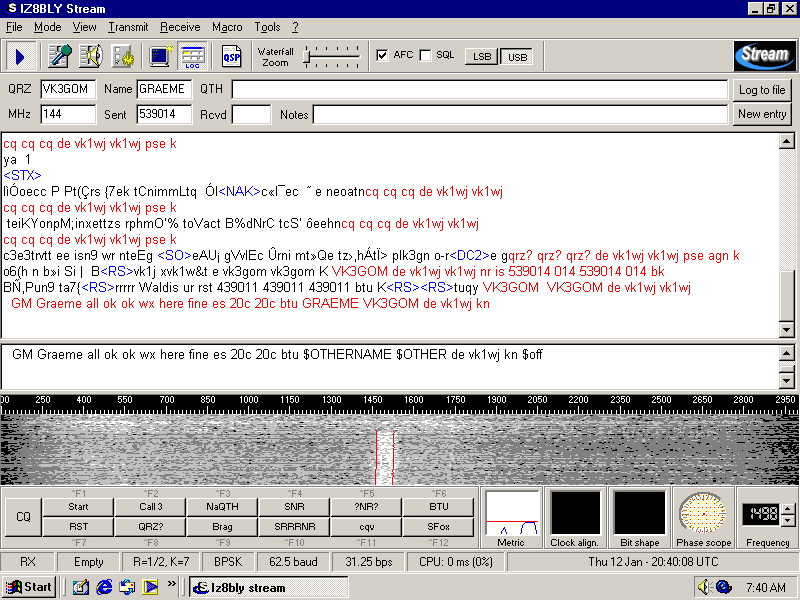
Screenshot 2m sked 26/12/05 with
VK3GOM - PSK220F under
Multipsk 3.10.1:
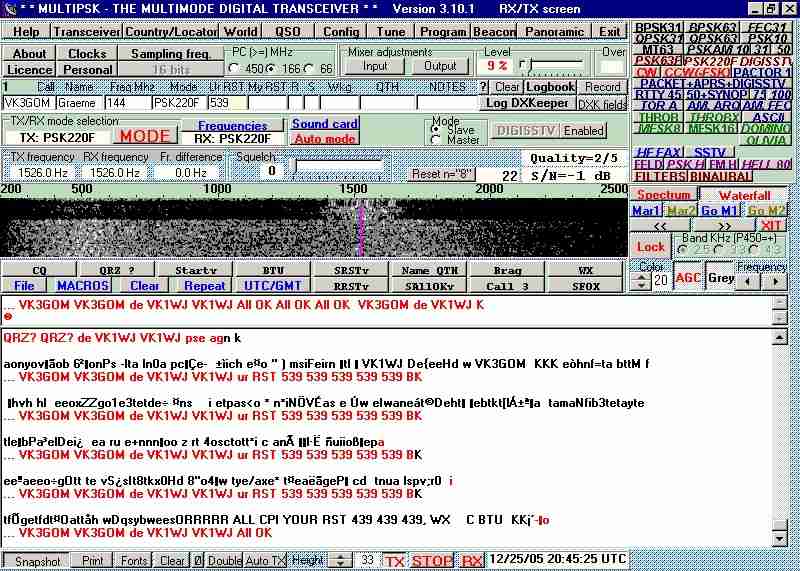
And here is a picture that we
transmitted during one of our skeds using the SSTV
capability of PSK220F:

Screenshot 2m sked 4/1/06 with
VK3GOM - BPSK63 under
Multipsk 3.10.1:
Note slant to higher frequencies and QSB ripple.
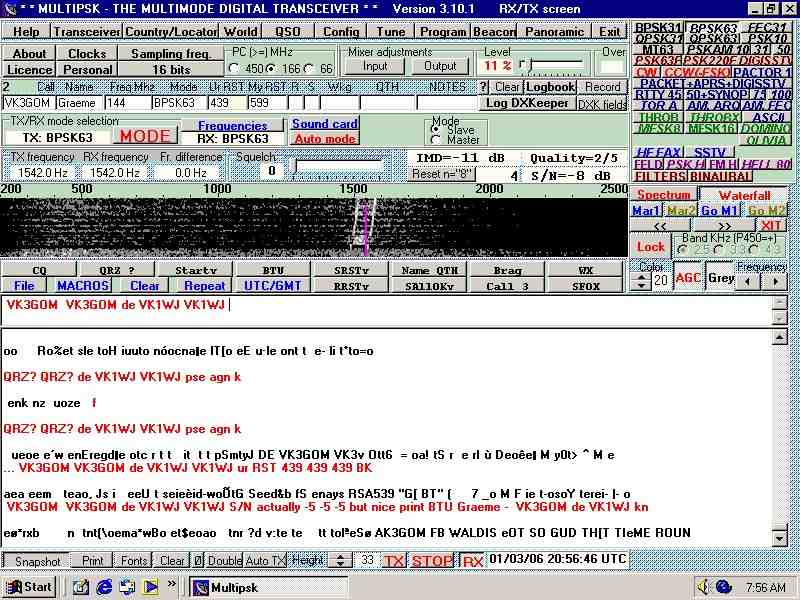
Screenshot 2m sked 15/3/06 with
VK3GOM - Domino EX 16 Baud
with FEC under Multipsk 3.13:
Note the weak signal strength.
